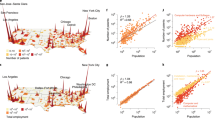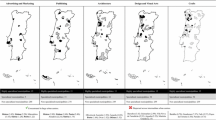Abstract
The hypothesis is that the major source of concentration of arts in different regions is due to agglomeration effects of specialized talents, city size, income, and quality of life. Twenty-nine large metropolitan areas are ranked and assessed for enhancing the climate for arts activity. Data on metropolitan areas in the United States on cost of living, transportation, employment, education, climate, crime, health care, recreation, city size, and per capita income are used as explanations for predominance of art in the 29 metropolitan areas. The results indicate that cities with larger populations and higher per capita income have greater concentrations of artistic activity. Other explanatory variables include factors associated with the quality of life. (JEL RIO, R23)
Similar content being viewed by others
References
Anderson, R., J.M. Quigley, and M. Wilhelmsson. 2005. “Agglomeration and the Spatial Distribution of Creativity.”Papers in Regional Science 84: 445–464.
Angrist, J.D. and A.B. Krueger. 1991. “Does Compulsory School Attendance Affect Schooling and Earnings?Quarterly Journal of Economics 106: 979–1014.
Berry, C.R., and E.L. Glaeser. 2005. “The Divergence of Human Capital Levels across Cities.”Papers in Regional Science 84: 407–444.
Blau, J.R. 1989.The Shape of Culture. Cambridge, UK: Cambridge University Press.
Blomquist, G.C., M.C. Berger, and J. Hoehn. 1988. “New Estimates of Quality of Life in Urban Areas.”American Economic Review 78: 89–107.
Bound, J., Jaeger, D.A., and R.M. Baker. 1995. “Problems with Instrumental Variables Estimation when the Correlation between the Instruments and the Endogenous Explanatory Variables is Weak.”Journal of the American Statistical Association 90: 443–450.
Bradford, N. 2007.Whither the Federal Urban Agenda? A New Deal in Transition, Canadian Policy Research Report F/65. Available at www.cprn.org.
Bureau of Economic Analysis. 2007. US Department of Commerce. Available at http://www.bea.gov/regional/reis/drill.fm.
Burnell, J.D., and G. Galster. 1992. “Quality of Life Measurements and Urban Size: An Empirical Note.”Urban Studies 29: 727–735.
Clark, D.E., and T.A. Knapp. 1995. “The Hedonic Price Structure of Faculty Compensations at U.S. Colleges and Universities.”The Review of Regional Studies 25: 117–142.
Congdon, P., and J. Shepherd. 1988. “Components of Social Change in Urban Areas.”Urban Studies, 25: 173–189.
Creedy, J. 1985.Dynamics of Income Distribution. Oxford, UK: Basil Blackwell Ltd.
Dougherty, C. 1992.Introduction to Econometrics. New York: Oxford University Press.
Ellis, M., R. Barff, and B. Renard. 1993. “Migration Regions and Interstate Labor Flows by Occupation in the United States.”Growth and Change 24: 166–190.
Florida, R. 2005. “The World is Spiky.”The Atlantic (October) 296: 48–51.
Griffiths, A. and A.M. Williams. 1992. “Culture, Regional Image, and Economic Development in the United Kingdom,”World Futures 33: 105–120.
Guetzkow, J. 2005.How the Arts Impact Communities: An Introduction to the Literature of Arts Impact Studies, Working Paper Series 20, http://www.princeton.edu/culturalpolicy/workpap/ WP20%20-%Guetzkow.pdf.
Hu, T. 1973.Econometrics: An Introductory Analysis. Baltimore: University Park Press.
Johansson, B. and J.M. Quigley. 2004. “Agglomeration and Networks in Spatial Economies.”Papers in Regional Science 83: 165–176.
Kosfeld, R. and C. Greger. 2006. “Thresholds for Employment and Unemployment: A Spatial Analysis of German Regional Labour Markets, 1992–2000.”Papers in Regional Science 85: 523–542.
Kotkin, J. 2007. “The Myth of Superstar Cities.”The Wall Street Journal (Tuesday February 13): A-25.
Kwoka, J.E., Jr. 1982. “Regularity and Diversity in Firm Size Distribution in U.S. Industries.”Journal of Economics and Business 34: 391–395.
Lin, G. and C. Christiadi. 2006. “Examining the Geographic and Occupational Mobility: A Loglinear Modelling Approach.”Papers in Regional Science 85: 505–522.
Lipshitz, G. and A. Raveh. 1994. “Application of the Co-Plot Method in the Study of SocioEconomic Differences between Cities: A Basis for a Differential Development Policy.”Urban Studies 31: 123–135.
Markusen, A. and D. King. 2003. “The Artistic Dividend: The Arts’ Hidden Contributions to Regional Development.” amarkusen@hhh.umn.edu July.
Markusen, A., G. Schrock, and M. Cameron. 2004. “The Artistic Dividend Revisited.” amarkusen@hhh.umn.edu March.
Mawson, J. 1995. “The Arts and Economic Development: Regional and Urban-Rural Contrasts in UK Local Authority Policies for the Arts.”Regional Studies 29: 73–80.
McCann, P. and J. Simonen. 2005. “Innovation, Knowledge Spillovers and Local Labour Markets.”Papers in Regional Science 84: 465–485.
Molotch, H. 2002. “Place in Products.”International Journal of Urban and Regional Research 26: 665–688.
Molotch, H. 2003.Where Stuff Comes From. New York: Routledge.
Myerscough, J. 1989.The Economic Importance of the Arts in Britain. London, UK: Public Policy Institute.
Rantisi, N.M. 2004. “The Ascendance of New York Fashion.”International Journal of Urban and Regional Research 28: 86–106.
Rey, S.J. and B. Dev. 2006. “σ-Convergence in the Presence of Spatial Effects.”Papers in Regional Science 85: 217–234.
Roback, J. 1982. “Wages, Rents, and the Quality of Life.”Journal of Political Economy 90: 1257–1278.
Savageau, D. and R. D’Agostino. 2000.Places Rated Almanac. Foster City, CA: MacMillan.
Scott, A.J. 2000.The Cultural Economy of Cities: Essays on the Geography of Image-Producing Industries. London: Sage Publications.
Stewart, K.G. 2005.Introduction to Applied Econometrics. Belmont, CA: Thomson Learning, Inc.
Stover, M.E. and C.L. Leven. 1992. “Methodological Issues in the Determination of the Quality of Life in Urban Areas.”Urban Studies 29: 737–754.
Theil, H. 1971.Principles of Econometrics. New York: John Wiley & Sons, Inc.
Van Oort, F.G. 2007. “Spatial and Sectoral Composition Effects of Agglomeration Economies in the Netherlands.”Papers in Regional Science 86: 5–30.
Whitehouse, M. 2007. “Is an Economist Qualified to Solve Puzzle of Autism?: Dismal Science Spreads its Wings to New Fields, Attracting Criticism.”The Wall Street Journal (Tuesday, February 27): A1, A14.
Wonnacott, R.J. and T.H. Wonnacott. 1970.Econometrics. New York: John Wiley & Sons, Inc.
Author information
Authors and Affiliations
Corresponding author
Rights and permissions
About this article
Cite this article
Nissan, E., Carter, G. Spatial distribution of the specialization of arts. J Econ Finan 31, 422–434 (2007). https://doi.org/10.1007/BF02885732
Issue Date:
DOI: https://doi.org/10.1007/BF02885732




